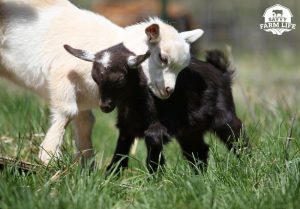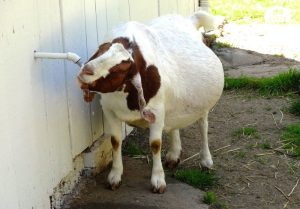
Ways to Tell if a Goat is Pregnant
If you have decided to breed your goats, you will undoubtedly be eager after the first mating to determine whether they are indeed pregnant or not. Goat gestation averages 150 days from conception to birth, but you won’t have to wait that long to find out if you will have a couple of new kids to look after.
How can you tell if your goat is pregnant? There are pregnancy tests that you or your vet can perform on your goat, but there are also several outward signs of pregnancy she may display, including:
- Failure to return to heat
- Swollen udders
- A hardened belly
- Personality changes
- Lack of interest in bucks
It will be easier to detect pregnancy in your goats if you regularly interact with and watch them. When you are familiar with your herd, you will find it much easier to notice some of the more subtle signs that can indicate you will be expecting kids soon – from changes in her personality to how she interacts with bucks.
Before Pregnancy: The Goat Estrous Cycle
Most goats are seasonal breeders, with does going into heat only in the Fall and Winter. Some breeds, however, will go into heat year-round. Out-of-season breeders include Boers and Nigerian Dwarfs. Out-of-season breeders will usually be bred three times in two years, producing more kids than seasonal breeders.
Whether year-round or seasonal, the doe will go into heat every 17-25 days during the goat’s breeding season. Most female goats will show several outward signs of being in heat, and “standing heat” – when the doe should be bred – lasts for only 12-48 hours. A day or two after the doe has experienced standing heat, she will ovulate.
While most does show signs of being in heat, some will have a “silent heat,” with few outward symptoms. One way to encourage heat in your does is to introduce a buck (the older and smellier, the more effective this will be) to the fence line. The presence of the mature goat will often induce a noticeable heat in the does.
While you can be more methodical in your breeding practices – observing for standing heat and introducing your buck to the does only during times of fertility – many breeders choose to leave a buck with a group of does for a full 40-45 days. This allows the female goats to fall pregnant over two estrous cycles, increasing the chances of success. It is advised against leaving your buck with your does throughout the breeding season, as the novelty will wear off, and they will become lazy about breeding.
To learn how to recognize the signs that your goat is in heat, visit my article Signs of Heat in Goats: 6 Signs a Goat is in Heat.
Physical Signs That Your Goat Is Pregnant
Your goat will show several physical symptoms of pregnancy, from subtle signs like a changing shape in the udders to more obvious signs like an absence of heat.
Pregnant Goats Will Not Go Into Heat

One of the most evident signs that your goat is pregnant will be the absence of going into heat. If a doe has been exposed to a buck during her previous cycle, keep an eye on her for signs of heat. If you don’t notice anything for 25 days, that is a good indication that the doe may be pregnant. While this is arguably one of the most evident indications of pregnancy, this method can be challenging if you have a doe who typically goes into silent heat.
A Pregnant Goat’s Udders Will Swell
As a doe’s pregnancy progresses, her udders will begin to swell, preparing to produce milk for her upcoming kids. While almost all pregnant goats will present with a swelling udder, the timing can vary significantly among individuals, making this a less reliable indication of how pregnant the doe is. Nevertheless, if you suspect that your doe may be pregnant, a swollen udder can be used as evidence of pregnancy.
A Pregnant Goat’s Belly Will Change Shape And Harden
Most goats have a barrel shape to their midsections, but the belly of a pregnant doe will become increasingly more prominent as she progresses in her gestation. The change in size will not be the only indicator of pregnancy – her belly will also harden. If you press into the belly of a goat that isn’t pregnant, her abdomen will probably be soft and squishy. On the other hand, if you press into the belly of a settled doe at least 2-4 weeks post-mating, her belly should become harder.
You May Be Able To Feel The Kids Of A Pregnant Doe
At around the 4-month mark of pregnancy, you should be able to feel kids moving around through palpation. Place your hands firmly along your doe’s belly and press around. You may feel the distinct shape of baby goats or even feel them moving around inside. At this point, you will likely have noticed other signs of pregnancy, such as a larger, hard belly and a swollen udder.
Behavior Signs That Your Goat Might Be Pregnant
In addition to the physical signs of goat pregnancy, you may notice a few behavioral changes. These include changes to your doe’s personality and how she will interact with a buck (and vice versa).
A Pregnant Goat’s Personality May Change
Just as is the case in people, hormonal changes can affect the personality of a goat in countless ways. If your doe was previously shy and flighty, you might find her confidently approaching you for a snack after she becomes pregnant. Likewise, your ordinarily sweet and gentle doe may become pushy or aggressive during pregnancy. These changes are normal and are a sign of her elevated pregnancy hormones.
A Pregnant Doe Will Ignore A Buck (and Vice Versa)
Both the pregnant doe and the buck can display this behavioral change. A pregnant doe will likely show no interest in a buck. She is not in heat and has no biological need to be around a buck or be mounted by a buck.
Likewise, a buck will also usually ignore a pregnant doe. Bucks can sense whether a doe is pregnant or not, and once his job is done, he has little interest in her.
To learn more about baby goats and the care they require, visit my article Baby Goats: What a Baby Goat is Called and Other Fun Facts.
Goat Pregnancy Tests
If you are looking for a more scientific approach to determining your doe’s status, you can perform a pregnancy test for goats. These include urine tests, blood tests, and ultrasounds.
Urine-Based Pregnancy Test
Between 15 and 20 days of conception, a doe’s level of estrone sulfate will significantly increase and remain higher throughout the pregnancy. When performed after day 50 of gestation, estrone sulfate tests have been shown to have 100% accuracy in detecting pregnancy. These tests are not readily available, and the cost can be prohibitive – contact your veterinarian for lab recommendations if you are interested in the estrone sulfate test.
Blood-Based Pregnancy Tests
Two main tests are performed to detect pregnancy through blood samples. One is the measurement of progesterone in the goat’s sample. While a handful of conditions may cause your doe’s progesterone concentration to be higher than average (pregnancy being only one of them), a low progesterone concentration will confirm that your doe is not pregnant. To get an accurate result with this test, the sample must be procured exactly one cycle post-breeding (17-25 days after the intended conception).
Another test can detect PSPB (pregnancy-specific protein B), a protein produced by the pregnant doe’s placenta. This test can detect pregnancy in goats as early as 30 days after breeding. The sample can be collected at home and shipped to one of the many participating labs. The most popular brand of PSPB test for goats is the BioPRYN, and a test kit can be purchased online.
Ultrasonographic Pregnancy Test
Transabdominal ultrasound can accurately detect pregnancy in a goat as early as 30-45 days from conception. While ultrasound may be more expensive than one of the blood tests mentioned above, there is a bonus in that you will be able to determine pregnancy and how many kids to expect. Most goats will frequently produce twins or triplets. An ultrasound can tell you whether your goat is pregnant and how many kids she is pregnant with.
What To Do If You Think Your Goat Is Pregnant
You must know whether your doe is pregnant to ensure her needs are met during this time and so that you can prepare for kidding. Pregnant does require high-quality forage and possible supplemental feed during the later stage of pregnancy. It is also essential that you keep their environment as stress-free as possible. If you have pregnant does, it is not the ideal time to move pastures, introduce new herd members, or change feed. Though goats are relatively hardy from birth, you will want to pay extra attention to expecting does.
Besides caring for your pregnant goats, it’s vital that you research how to care for the kids once they are born. One aspect of this is knowing how to introduce grain into a baby goat’s diet. To learn more on this, visit my article When Do Baby Goats Start Eating Grain?
